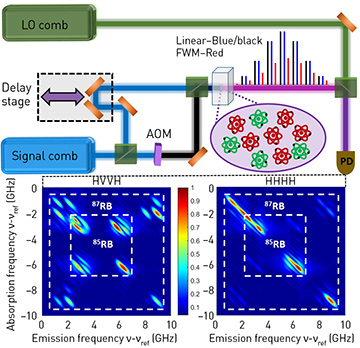 Top: Schematic of M-DCS setup. Bottom: 2-D spectra taken with cross (HVVH) and co-linearly polarized (HHHH) excitation pulses. H, horizontal; V, vertical; LO, local oscillator; AOM, acousto-optical modulator; PD, photodetector. νref = 377.103258084 THz.
Top: Schematic of M-DCS setup. Bottom: 2-D spectra taken with cross (HVVH) and co-linearly polarized (HHHH) excitation pulses. H, horizontal; V, vertical; LO, local oscillator; AOM, acousto-optical modulator; PD, photodetector. νref = 377.103258084 THz.
Optical multidimensional coherent spectroscopy (MDCS) is a powerful method for probing the structure and ultrafast dynamics of materials.1 MDCS allows users to decouple homogenous and inhomogeneous broadening, to identify couplings between excited states and to track the energy redistribution in complex systems on femtosecond timescales. While MDCS methods have been developed both in the visible and IR regions, these methods either have long acquisition times or suffer from spectral resolution limitations due to the spectrometer capabilities or the achievable time delays between excitation pulses. These constraints limit applicability for atomic physics and molecular rotational-vibrational spectroscopy.
Frequency-comb techniques, meanwhile—particularly dual-comb spectroscopy (DCS)—have revolutionized optical spectroscopy, offering high resolution, broad spectral coverage and fast acquisition speed.2 Yet DCS shares two drawbacks of other 1-D optical methods: an inability to distinguish whether the resonances are from the same or different species, and inhomogeneous broadening of measured linewidths. Recently we married MDCS and DCS, creating a multidimensional dual-comb spectroscopy (M-DCS) technique, and demonstrated rapid multidimensional coherent spectroscopy with the highest reported spectral resolution to date.3
M-DCS is a form of four-wave-mixing (FWM) spectroscopy. Two combs with different offset frequencies, produced from a single signal comb using an acousto-optical modulator, interact with Rb vapor at 110 °C (Doppler broadened) and generate a FWM signal in a collinear geometry for varying delay. A local-oscillator comb with a different repetition rate produces RF signals by heterodyning with the excitation and signal combs. The FWM signal comb is spectrally isolated from the excitation combs in the RF domain.4 A 2-D coherent spectrum is produced by Fourier transforming the FWM signal with respect to both the delay between pulses and the period over which the signal is emitted.
The spectra (see figure) show well-resolved peaks from hyperfine split transitions separated by around 362 MHz, demonstrating the resolution. The peaks are diagonally elongated due the Doppler broadening, but the transverse width is limited only by the length of the delay scan between the excitation pulses. White dashed boxes in the figure show the identification of Rb isotopes (87Rb and 85Rb) based on the placement and coupling of their hyperfine states on the 2-D spectra.
The spectra were acquired in less than four minutes; further, replacing the delay stage with a third comb should provide further reductions in acquisition time and improvement in the spectral resolution. The use of micro-combs will, we believe, make this method fully field deployable for chemical-sensing applications.
Researchers
Bachana Lomsadze and Steven T. Cundiff, University of Michigan, Ann Arbor, Mich., USA, and JILA, University of Colorado and National Institute of Standards and Technology, Boulder, Colo. USA
References
1. S.T. Cundiff and S. Mukamel. Phys. Today 66(7), 44 (2013).
2. I.Coddington et al. Optica 3, 414 (2016).
3. B. Lomsadze and S.T. Cundiff. Science 357, 1389 (2017).
4. B. Lomsadze and S.T. Cundiff. Opt. Lett. 42, 2346 (2017).
